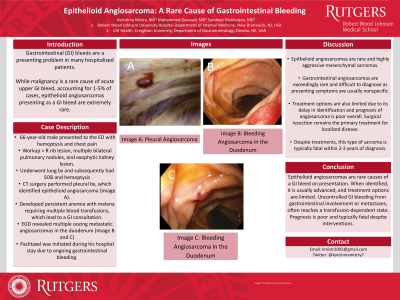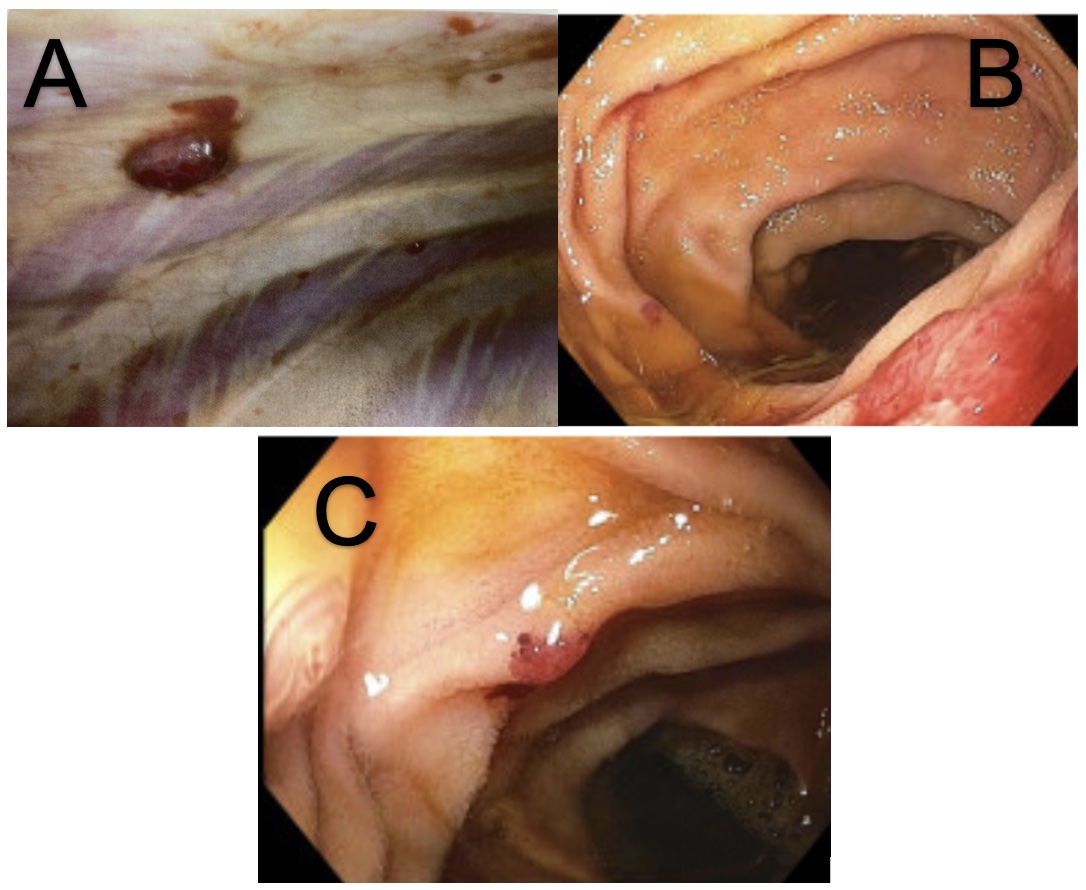Sunday Poster Session
Category: GI Bleeding
P0792 - Epithelioid Angiosarcoma: A Rare Cause of Gastrointestinal Bleeding
Sunday, October 27, 2024
3:30 PM - 7:00 PM ET
Location: Exhibit Hall E


Karishma Mistry, MD
CHI Health Creighton University Medical Center
North Wales, PA
Presenting Author(s)
Karishma Mistry, MD, Mohammed Qasswal, MD, Sandeep Mukherjee, MD
CHI Health Creighton University Medical Center, Omaha, NE
Introduction: Gastrointestinal (GI) bleeds are a presenting problem in hospitalized patients. While malignancy is a rare cause of acute upper GI bleed, accounting for 1-5% of cases, epithelioid angiosarcomas presenting as a GI bleed are extremely rare. Here we present a case of epithelioid angiosarcoma diagnosed during the workup of melena and persistent anemia.
Case Description/Methods: A 66-year-old male presented to the emergency department (ED) complaining of hemoptysis and chest pain. Computed tomography (CT) right sided rib lesion, multiple bilateral pulmonary nodules, and exophytic kidney lesion. He was referred to the oncology clinic, where renal cell carcinoma was suspected, and was subsequently sent to interventional radiology for lung biopsy. 2 weeks after the biopsy, he experienced shortness of breath and hemoptysis, prompting the return to the ED. CT angiography of the chest showed a large loculated right-sided pleural effusion with multiple hyperdense pleural lesion suspicious for pleural metastasis. Cardiothoracic surgery performed video-assisted thoracoscopic surgery with pleural biopsy, which identified epithelioid angiosarcoma (image1). During hospitalization, the patient developed persistent anemia with melena requiring multiple blood transfusions, which lead to a GI consultation. An esophagogastroduodenoscopy (EGD) revealed multiple oozing metastatic angiosarcomas in the duodenum (image 2 and 3), no intervention was done. Following multidisciplinary discussion, Paclitaxel was initiated during his hospital stay due to ongoing gastrointestinal bleeding. He was discharged and his hemoglobin stabilized during follow-up with oncology one week later.
Discussion: Epithelioid angiosarcomas are rare and highly aggressive mesenchymal sarcomas. They can occur in any part of the body, however gastrointestinal angiosarcomas are exceedingly rare. Gastrointestinal angiosarcomas are difficult to diagnose as presenting symptoms are usually nonspecific, leading to delayed diagnosis. Treatment options are also limited due to its delay in identification and prognosis of angiosarcoma is poor overall. Surgical resection remains the primary treatment for localized disease. Adjuvant chemotherapy and radiation therapy are options for patients with disseminated disease. Uncontrolled GI bleeding from their gastrointestinal involvement or metastases, often reach a transfusion-dependent state. Despite treatments, this type of sarcoma is typically fatal within 2-3 years of diagnosis.

Disclosures:
Karishma Mistry, MD, Mohammed Qasswal, MD, Sandeep Mukherjee, MD. P0792 - Epithelioid Angiosarcoma: A Rare Cause of Gastrointestinal Bleeding, ACG 2024 Annual Scientific Meeting Abstracts. Philadelphia, PA: American College of Gastroenterology.
CHI Health Creighton University Medical Center, Omaha, NE
Introduction: Gastrointestinal (GI) bleeds are a presenting problem in hospitalized patients. While malignancy is a rare cause of acute upper GI bleed, accounting for 1-5% of cases, epithelioid angiosarcomas presenting as a GI bleed are extremely rare. Here we present a case of epithelioid angiosarcoma diagnosed during the workup of melena and persistent anemia.
Case Description/Methods: A 66-year-old male presented to the emergency department (ED) complaining of hemoptysis and chest pain. Computed tomography (CT) right sided rib lesion, multiple bilateral pulmonary nodules, and exophytic kidney lesion. He was referred to the oncology clinic, where renal cell carcinoma was suspected, and was subsequently sent to interventional radiology for lung biopsy. 2 weeks after the biopsy, he experienced shortness of breath and hemoptysis, prompting the return to the ED. CT angiography of the chest showed a large loculated right-sided pleural effusion with multiple hyperdense pleural lesion suspicious for pleural metastasis. Cardiothoracic surgery performed video-assisted thoracoscopic surgery with pleural biopsy, which identified epithelioid angiosarcoma (image1). During hospitalization, the patient developed persistent anemia with melena requiring multiple blood transfusions, which lead to a GI consultation. An esophagogastroduodenoscopy (EGD) revealed multiple oozing metastatic angiosarcomas in the duodenum (image 2 and 3), no intervention was done. Following multidisciplinary discussion, Paclitaxel was initiated during his hospital stay due to ongoing gastrointestinal bleeding. He was discharged and his hemoglobin stabilized during follow-up with oncology one week later.
Discussion: Epithelioid angiosarcomas are rare and highly aggressive mesenchymal sarcomas. They can occur in any part of the body, however gastrointestinal angiosarcomas are exceedingly rare. Gastrointestinal angiosarcomas are difficult to diagnose as presenting symptoms are usually nonspecific, leading to delayed diagnosis. Treatment options are also limited due to its delay in identification and prognosis of angiosarcoma is poor overall. Surgical resection remains the primary treatment for localized disease. Adjuvant chemotherapy and radiation therapy are options for patients with disseminated disease. Uncontrolled GI bleeding from their gastrointestinal involvement or metastases, often reach a transfusion-dependent state. Despite treatments, this type of sarcoma is typically fatal within 2-3 years of diagnosis.

Figure: A: Pleural Angiosarcoma
B: Bleeding Angiosarcoma in the Duodenum
C: Bleeding Angiosarcoma in the Duodenum
B: Bleeding Angiosarcoma in the Duodenum
C: Bleeding Angiosarcoma in the Duodenum
Disclosures:
Karishma Mistry indicated no relevant financial relationships.
Mohammed Qasswal indicated no relevant financial relationships.
Sandeep Mukherjee indicated no relevant financial relationships.
Karishma Mistry, MD, Mohammed Qasswal, MD, Sandeep Mukherjee, MD. P0792 - Epithelioid Angiosarcoma: A Rare Cause of Gastrointestinal Bleeding, ACG 2024 Annual Scientific Meeting Abstracts. Philadelphia, PA: American College of Gastroenterology.
